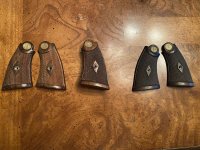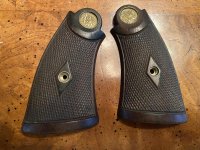Masterpiece
Member
Smith & Wesson's quality control would not allow for a set of grips that did not contain an escutcheon perfectly centered on the diamond and is proof that this set and the OPs cannot contain factory original checkering (or checking).
mrcvs,
Sorry to disagree, but that's a pretty hard statement to confirm without confirmation of a Factory Engineering Order or Notation stating so noted in Factory Documents!!
Especially so given over the past 50+ years I've observed first-hand possibly hundreds known "Guaranteed Factory Original" Checked Stocks that don't fit the description you're describing...Very rarely are many "Picture Perfect" given in that time period these were checked by Human Hands...Not by Machines!!



